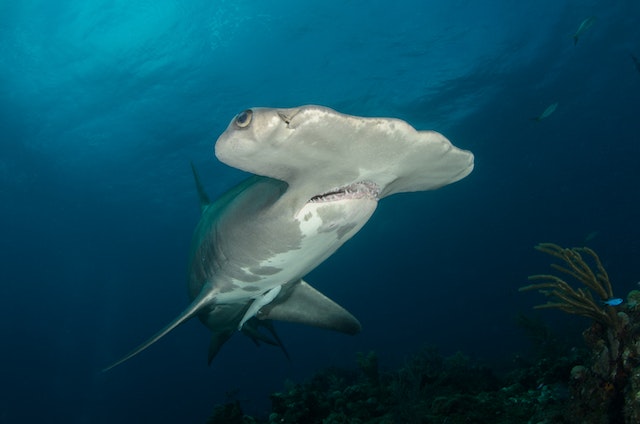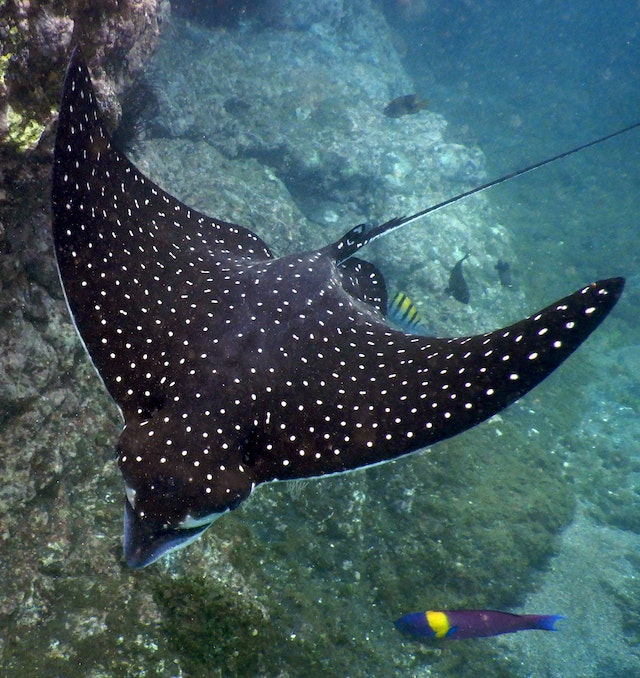
Hammerhead Incredible Facts
Hammerhead sharks are one of the most easily recognisable sea creatures. They have a huge distinctive hammer like, large head which gives it it’s name.
Here are 10 incredible facts about these unusual creatures.
1. They are relatively new on Earth
What is interesting is that while sharks have been around for around 420 million years, hammerhead sharks are relatively new on the planet, since around 20 million years (As a context, dinosaurs went extinct 65 million years ago. So these species came much later).
This is interesting because evolution clearly favored the streamlined body with a pointed face which resulted in most fish having that same shape. If that is the case, why did hammerheads evolve, that too much later in the evolution cycle? How have they managed to become the fierce predators they are? What gives them an edge?
The facts below will answer some of these questions.
2. At least 10 known species of Hammerheads
Scientists have identified at least 10 living species of the hammerhead sharks. Nine belong to the genus Sphyrna (Greek for “hammer”), while the other—the winghead shark—is so far the sole member of its own genus, Eusphyra.
The winghead shark has the largest head to body ratio, its head being almost half as wide as its body!
They vary in size. The smallest species is only 3 to 5 feet long whereas the larges, the Great Hammerhead, can grow up to 18 feet long!
3. Better Vision
The eyes of the hammerhead sharks are placed on the sides of their hammer like heads, called the cephalofoil. Most predators have front facing eyes which causes an overlap of what each eye can see independently (called binocular overlap), resulting in a better understanding of depth which is very important for predators. On the other hand, the prey have eyes on the sides so that they have a larger angle of vision, though not so much of depth.
Though unintuitive, but when the scientists studied the field of vision in hammerheads, they realised that not only does the eyes have an almost 360degress view but also better depth. the broader the cephalofoil, the greater is the overlap in the vision and better is the depth perception. Thus, the hammer shape actually gives these sharks a much wider and better view of their surroundings making them fierce predators.
4. Better Electroreception ability
Electroreception ability is the ability to detect minute and invisible electric fields in water. A lot of aquatic animals have this ability since water is a better conductor of electric pulses than air. All sharks also have this ability, but hammerheads take it to an all new level. Their large head has many more pores and receptors than any other type of shark giving them the ability to sense very minute signals as well.
Even newborn bonnethead sharks can detect electric fields less than 1 nanovolt per square centimeter. This sensitivity is over 5 million times greater than anything humans could ever feel. It is likely the most powerful electrical sensing in the animal kingdom.
5. Better maneuverability
Their large cephalofoil gives increased maneuverability to hammerheads, helping it follow and catch prey on the seabed like octopus or stingrays. The large headed, winghead shark, therefore has the highest maneuverability. This has been ratified by the scientists as well. This allows the winghead shark to hunt teleost fishes like herrings, (93% of their diet are teleost fish), which are known to be very fast and very agile.
Read 10 Interesting Facts About Ocean Animals
6. Favorite Food – Stingray
Stingrays are the favorite food of many types of hammerhead sharks. When it goes out to hunt, its electric sensors help it to locate the prey on the seabed. Then its hammer like head gives it the maneuverability to follow its prey. And it doesn’t end there. The head is useful even after this!
They use their head to ram into and pin down the stingrays, making it easier for them to eat their favorite meal.
They also eat bony fishes, crabs, squid, lobsters, and other sea creatures.

7. They give birth to pups
Hammerheads do not lay eggs but give birth to young ones, called pups. At one time, they may give birth to a litter of 6 to 50 babies.
A bizarre fact is about a bonnethead shark in captivity at an Omaha in an all female Nebraska aquarium. One of them had a virgin birth, that is to say, birth without the contribution of a male. Testing confirmed that the new shark did not have any paternal DNA!
8. Scalloped Hammerheads get tans
Scalloped hammerheads swim in shallow waters and have been known to get tanned. In a press release, scientists said, “These sharks increased the melanin content in their skin by 14% over 21 days, and up to 28% over 215 days. This study represents the first documented case of suntanning in lower vertebrates”
9. Great hammerheads swim sideways
Most sharks have 8 fins, the pectoral fins being larger than the first dorsal fins. But the opposite is true for the Great Hammerheads. In a 2016 study, scientists saw that they spent almost 90% of their time swimming tilted at an angle of 50 to 75 degrees. This reduces drag and allows them to swim more efficiently.
10. Stingray barbs don’t affect them
Stingray barbs cause fever, nausea, swelling, and even seizures in humans. They have even resulted in some human deaths. However, hammerhead sharks seem to be unaffected by them. in fact, many great hammerheads have been found with pieces of stingray barbs embedded in their faces.
Read more articles on 10 Interesting Fact Series
Sources:
- kids.nationalgeographic.com
- RealScience you tube video
- a-z-animals.com
- mentalfloss.com
- http://www.csulb.edu/shark-lab/suntanning-sharks


Your post was intriguing to read, and so kept reading as well as facts, learned new words along the way too. Amazing creatures.
LikeLiked by 1 person
Thank you so much for your kind words. Its great to know that you found it useful.
LikeLike
This was fascinating; I had no idea there was so much to know and learn about hammerhead sharks!
LikeLiked by 1 person
Thank you Molly! I’m glad you liked the article.
LikeLike
Wow! Thanks for sharing such an interesting facts! But I’m so sad with the fact that they eat stingrays. Stingrays are so cute 🥲
Meadow | https://about.me/meadowsimmons
LikeLiked by 1 person
Thank you. I’m glad you liked it. I agree – stingrays are cute, but hammerheads also have to eat. The good thing about animals is, that unlike humans, they maintain a good balance in their habitat and surroundings.
LikeLike
Hammerhead sharks are quite lovely. Thank you for sharing this interesting facts about them. Very educational post. I enjoyed it a lot.
LikeLiked by 1 person
Thank you. I’m glad you enjoyed it.
LikeLike